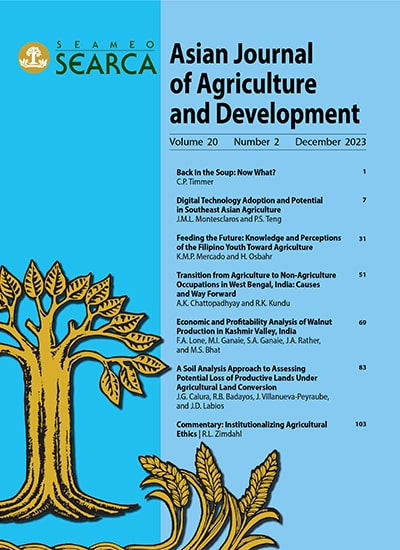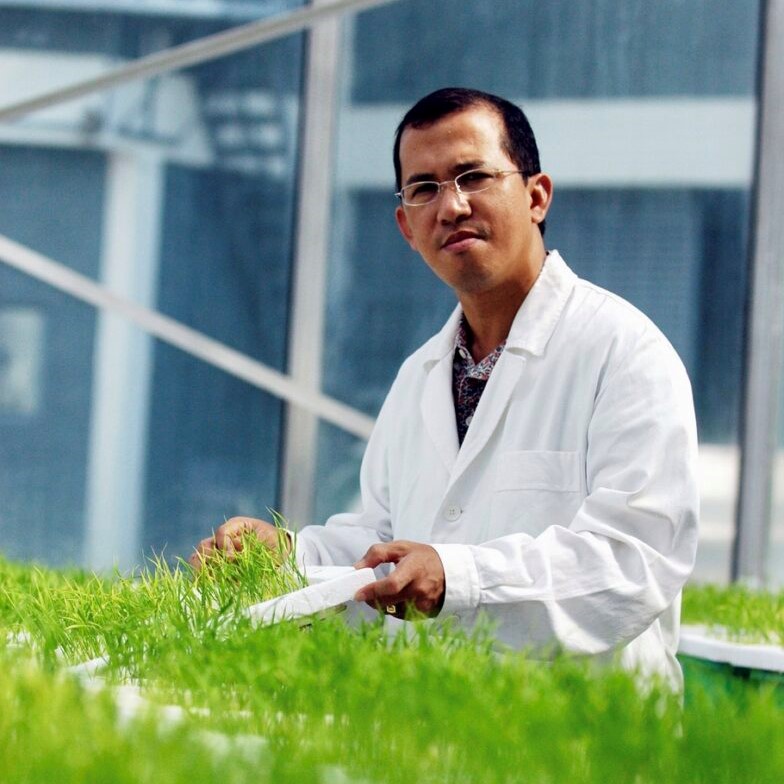The pivotal role of the agriculture sector in Southeast Asia (SEA) in driving the socioeconomic transformation of the region is highlighted by several studies presented in the December 2023 edition of the Asian Journal of Agriculture and Development (AJAD). However, these studies also underscore the sector’s exposure to risks and challenges.

AJAD is an internationally refereed journal published by the Philippine government-hosted, Los Baños-based Southeast Asian Regional Center for Graduate Study and Research in Agriculture (SEARCA).
According to SEARCA Center Director Glenn Gregorio, the combined optimism of the authors “offers a glimpse of hope for the ongoing role of the region as a significant global producer and exporter.”
In his paper titled “Back in the Soup: Now What?”, esteemed food security expert and Harvard University professor emeritus C. Peter Timmer examines the global rice market’s outlook as of early September 2023. Timmer expands upon his previous AJAD article from a year ago, addressing the management of an impending world food crisis post-pandemic and presenting a “series of steps designed to instill confidence in the availability of supplies.”
In this latest paper, Timmer analyzes the current concerns surrounding a potential rice crisis due to attacks on the infrastructure of Ukraine’s food export system and the onset of a severe El Niño in Asian rice-producing regions.
Highlighting the possible repercussions of a spike in rice prices leading to widespread hunger through extensive hoarding, Timmer recommends that governments stabilize expectations to avert a rice crisis by maintaining a reasonable interaction with market players.
Taking a historical perspective, Timmer examines past rice crises and how different states addressed them, emphasizing that “the focus should be on the impact of higher rice prices on the food security of the poor, rather than aggregate inflation.”
Meanwhile, in their paper titled “Digital Technology Adoption and Potential in Southeast Asian Agriculture,” Jose Ma Luis Montesclaros and Paul Teng of Nanyang Technological University in Singapore provide an affirmative response to the question of whether digital technologies can play a more significant role in addressing the ongoing challenges faced by Southeast Asia’s agriculture sector concerning food security, income, trade, and employment.
Montesclaros and Teng propose a common framework for understanding the emerging digital technology in agriculture, offering insights into its adoption status in the region, key challenges, and policy opportunities for scaling up.
The authors identify shared challenges across the region, stemming from “climate change, degradation of land and freshwater resources, pests and diseases, declining crop productivity, high input costs, decreasing rural labor force, and aging farmers,” necessitating innovative solutions.
Examining the role of youth in farming, Kringle Marie Mercado and Henny Osbahr, in their paper “Feeding the Future: Knowledge and Perceptions of the Filipino Youth Toward Agriculture,” explore the Filipino youth’s inclination to enroll in agricultural degree programs.
According to Mercado and Osbahr, the youth play a crucial role in sustaining and developing a sustainable, resilient, and inclusive agriculture industry. Their case study in General Santos City, Philippines, reveals that while the youth are exposed to agricultural information, it has not translated into practical knowledge, with limited awareness of agricultural professions. The authors suggest intervention programs starting early in the youth curriculum, along with social initiatives emphasizing capacity building, to cultivate interest in the industry and encourage engagement in its professions.
Meanwhile, Apurba Kumar Chattopadhyay and Raj Kumar Kundu, in their paper titled “Transition from Agriculture to Non-Agriculture Occupations in West Bengal, India: Causes and Way Forward,” demonstrate that agriculture in West Bengal is nonviable as a primary occupation for most agricultural households. Limited opportunities in rural areas prompt individuals to seek jobs outside agriculture. The authors advocate for increasing average operational landholdings through reverse tenancy, cooperative farming, and creating gainful employment opportunities in the rural nonfarm sector to facilitate the transition from agricultural to nonagricultural occupations.
Fayaz Ahmad Lone and co-authors, in their study titled “Economic and Profitability Analysis of Walnut Production in Kashmir Valley, India,” reveal that walnut cultivation is highly labor-intensive, constituting 80 percent of total production costs. Despite the high costs, the cost-benefit ratio in Kashmir Valley indicates favorable economic prospects. The study suggests policy interventions to improve access to extension services, credit, and farmer training programs to boost walnut production in the region.
The paper by Jordan Calura and co-authors, titled “A Soil Analysis Approach to Assessing Potential Loss of Productive Lands Under Agricultural Land Conversion,” assesses the productivity of agricultural lands in Pura, Tarlac, Philippines, predisposed to agricultural land conversion. Soil surveys and composite soil sampling indicate marginal suitability for rice and other crops, but with appropriate soil management, the land can be highly suitable for crop production. The authors argue that land in Pura is productive and can benefit both agricultural production and land conversion.

In the commentary by Colorado State University professor emeritus Robert Zimdahl, titled “Institutionalizing Agricultural Ethics,” it is argued that the agricultural science curriculum lacks consideration of the ethical dilemmas of agriculture on society. Zimdahl suggests that agriculture, being a fundamental human activity, requires a defined moral foundation. He warns that ignoring these ethical dilemmas may lead to justifications for technology and production practices being ignored, increased societal unrest, pressure for political action due to public dissatisfaction, and the continued concentration of food production in the hands of agribusiness companies, leading to the gradual disappearance of small farms, farmers, and rural communities.

The SEARCA Director said AJAD publishes articles resulting from empirical, policy-oriented, or institutional development studies, as well as perspectives on agriculture and development, political economy of rural development, and trade issues. He added that submissions are welcome year-round through https://ajad.searca.org, and all new and past papers are accessible for free on the site, with print copies available through subscription.#




